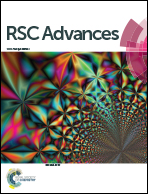Insight into the short-term effect of titanium dioxide nanoparticles on active ammonia oxidizing microorganisms in a full-scale wastewater treatment plant: a DNA-stable isotope probing study
Abstract
Ammonia-oxidizing bacteria (AOB) and archaea (AOA) are two distinct ammonia-oxidizing microorganisms (AOMs) responsible for nitrification in wastewater treatment plants (WWTPs). However, their relative contributions to ammonia oxidation in WWTPs and short-term responses to titanium dioxide nanoparticles (TiO2 NPs) remain unclear. In this study, DNA-based stable isotope probing (DNA-SIP), quantitative polymerase chain reaction (qPCR), PCR, cloning and sequencing were applied to investigate the in situ activity of AOMs in a full-scale WWTP and to evaluate their responses to TiO2 NPs. An environmentally relevant concentration (1 mg L−1) and a higher concentration (50 mg L−1) of TiO2 NPs were chosen for laboratory microcosms. The laboratory microcosms revealed that TiO2 NPs (1 or 50 mg L−1) caused slight or no short-term inhibitions on nitrification activity and nitrification rate of activated sludge. The successful Na213CO3 assimilation of AOB rather than AOA in original sludge provided compelling evidence for the strong contribution of AOB to the in situ nitrification of the WWTP. The main AOB in original sludge, Nitrosomonas oligotropha cluster and Nitrosomonas europaea cluster, were the dominant active AOB in the WWTP. However, compared with the original sludge, the abundance and distribution of active AOB changed under 1 and 50 mg L−1 of TiO2 NPs. In particular, AOA within Nitrososphaera cluster were the active AOMs under 50 mg L−1 TiO2 NPs. These results suggested that TiO2 NPs had a potential impact on the abundance and composition of active AOMs in the WWTP. This study further provided direct evidence of the autotrophic growth of AOB within N. oligotropha cluster and N. europaea cluster, and AOA within the general Nitrososphaera cluster. Overall, AOB played an important role in the in situ nitrification of the full-scale WWTP investigated, while AOA showed a strong contribution to the active nitrification under higher concentration of TiO2 NPs.


 Please wait while we load your content...
Please wait while we load your content...